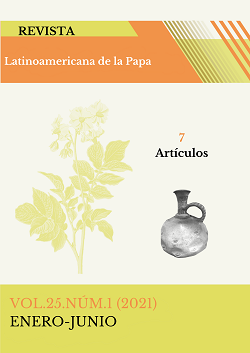Economic analysis of the agricultural supply of commercial varieties of peruvian potatoes
##plugins.themes.bootstrap3.article.main##
Abstract
This paper aims to identify the most relevant variables that explain the economic supply of potato “Solanum tuberosum”, in its two varieties: modern and native, in growers in the Huasahuasi district, in the Junín department of Peru. The methodology used was the Stochastic Monte Carlo Simulation to evaluate the profitability and intrinsic risk of agricultural production in both types of supply. The results show that there is no significant difference in the profitability and risk of these two varieties: The expected value of the profitability, as well as the minimum and maximum value of this variable, in the case of modern potatoes, are: S /. 9639, S /. -6290; and S /. 28476. In the case of native potatoes, these values correspond to S /. 7240, S /. -3754; and S /. 24476. Also, it was found that these growers offer a greater quantity of modern potato compared to native potato, since productivity per unit of land; and the cultivated area, average per grower, amounts to 27 t.ha-1 and 16 t.ha-1; and 2,46 ha and 1,26 ha, for modern and native potatoes, respectively. However, the effective purchase - by intermediaries -; and access to large markets are the most relevant variables in making economic decisions regarding the aggregate supply of potatoes in Huasahuasi.
Additional Keywords: Agricultural supply, profitability, commercial potatoes, stochastic simulation.
Download Statistics
##plugins.themes.bootstrap3.article.details##

This work is licensed under a Creative Commons Attribution-NonCommercial-ShareAlike 4.0 International License.


 https://orcid.org/0000-0003-1691-6585
https://orcid.org/0000-0003-1691-6585